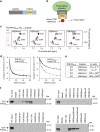Mechanistic insights into chromatin targeting by leukemic NUP98-PHF23 fusion
- PMID: 32620764
- PMCID: PMC7335091
- DOI: 10.1038/s41467-020-17098-4
Mechanistic insights into chromatin targeting by leukemic NUP98-PHF23 fusion
Abstract
Chromosomal NUP98-PHF23 translocation is associated with an aggressive form of acute myeloid leukemia (AML) and poor survival rate. Here, we report the molecular mechanisms by which NUP98-PHF23 recognizes the histone mark H3K4me3 and is inhibited by small molecule compounds, including disulfiram that directly targets the PHD finger of PHF23 (PHF23PHD). Our data support a critical role for the PHD fingers of NUP98-PHF23, and related NUP98-KDM5A and NUP98-BPTF fusions in driving leukemogenesis, and demonstrate that blocking this interaction in NUP98-PHF23 expressing AML cells leads to cell death through necrotic and late apoptosis pathways. An overlap of NUP98-KDM5A oncoprotein binding sites and H3K4me3-positive loci at the Hoxa/b gene clusters and Meis1 in ChIP-seq, together with NMR analysis of the H3K4me3-binding sites of the PHD fingers from PHF23, KDM5A and BPTF, suggests a common PHD finger-dependent mechanism that promotes leukemogenesis by this type of NUP98 fusions. Our findings highlight the direct correlation between the abilities of NUP98-PHD finger fusion chimeras to associate with H3K4me3-enriched chromatin and leukemic transformation.
Conflict of interest statement
The authors declare no competing interests.
Figures






Similar articles
-
NUP98-PHF23 is a chromatin-modifying oncoprotein that causes a wide array of leukemias sensitive to inhibition of PHD histone reader function.Cancer Discov. 2014 May;4(5):564-77. doi: 10.1158/2159-8290.CD-13-0419. Epub 2014 Feb 17. Cancer Discov. 2014. PMID: 24535671 Free PMC article.
-
Haematopoietic malignancies caused by dysregulation of a chromatin-binding PHD finger.Nature. 2009 Jun 11;459(7248):847-51. doi: 10.1038/nature08036. Nature. 2009. PMID: 19430464 Free PMC article.
-
Regulation of differentiation by a PHD domain in the NUP98-PHF23 fusion protein.Leuk Res. 2010 Aug;34(8):1094-7. doi: 10.1016/j.leukres.2010.02.015. Epub 2010 Mar 12. Leuk Res. 2010. PMID: 20219246
-
A cryptic translocation leading to NUP98-PHF23 fusion in AML.Best Pract Res Clin Haematol. 2016 Dec;29(4):320-323. doi: 10.1016/j.beha.2016.10.002. Epub 2016 Oct 18. Best Pract Res Clin Haematol. 2016. PMID: 27890253 Review.
-
Fusion of the NUP98 gene and the homeobox gene HOXC13 in acute myeloid leukemia with t(11;12)(p15;q13).Genes Chromosomes Cancer. 2003 Jan;36(1):107-12. doi: 10.1002/gcc.10139. Genes Chromosomes Cancer. 2003. PMID: 12461755 Review.
Cited by
-
Opportunity knocks for uncovering the new function of an understudied nucleosome remodeling complex member, the bromodomain PHD finger transcription factor, BPTF.Curr Opin Chem Biol. 2021 Aug;63:57-67. doi: 10.1016/j.cbpa.2021.02.003. Epub 2021 Mar 8. Curr Opin Chem Biol. 2021. PMID: 33706239 Free PMC article. Review.
-
HoxBlinc lncRNA reprograms CTCF-independent TADs to drive leukemic transcription and HSC dysregulation in NUP98-rearranged leukemia.J Clin Invest. 2025 Jan 30;135(7):e184743. doi: 10.1172/JCI184743. J Clin Invest. 2025. PMID: 39883527 Free PMC article.
-
The language of chromatin modification in human cancers.Nat Rev Cancer. 2021 Jul;21(7):413-430. doi: 10.1038/s41568-021-00357-x. Epub 2021 May 17. Nat Rev Cancer. 2021. PMID: 34002060 Free PMC article. Review.
-
The Retinoblastoma Tumor Suppressor Is Required for the NUP98-HOXA9-Induced Aberrant Nuclear Envelope Phenotype.Cells. 2021 Oct 22;10(11):2851. doi: 10.3390/cells10112851. Cells. 2021. PMID: 34831074 Free PMC article.
-
Domain architecture and protein-protein interactions regulate KDM5A recruitment to the chromatin.Epigenetics. 2023 Dec;18(1):2268813. doi: 10.1080/15592294.2023.2268813. Epub 2023 Oct 15. Epigenetics. 2023. PMID: 37838974 Free PMC article. Review.
References
-
- Ahuja HG, et al. t(9;11)(p22;p15) in acute myeloid leukemia results in a fusion between NUP98 and the gene encoding transcriptional coactivators p52 and p75-lens epithelium-derived growth factor (LEDGF) Cancer Res. 2000;60:6227–6229. - PubMed
Publication types
MeSH terms
Substances
Grants and funding
LinkOut - more resources
Full Text Sources
Molecular Biology Databases

